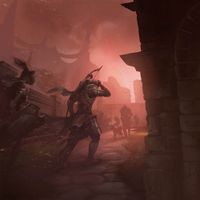This article is about the event. For the book, see The Red Year.
4E 5[1] came to be known as the Red Year due to the fulfillment of the Nerevarine Prophecy and the disappearance of Vivec in the late Third Era. With the warrior-poet Tribune gone, there was nothing holding Baar Dau in place over Vivec City in the Vvardenfell district of Morrowind.[2] An Ingenium powered by souls was created to hold the moon in place, used to create a rift to the Fields of Regret through which souls were funneled to Clavicus Vile and the energies of the realm were leeched to hold the moon in place. The mage Sul, who was one of the designers of Ingenium, theorized that the Daedric Prince did not care for the stolen energies as he valued the souls he received in exchange more, and that the other architect of the project, Vuhon, might have even made a formal pact with Vile for him to allow the energies to be taken.[3] This worked until the first few years of the Fourth Era, when a Dunmer named Sul destroyed the Ingenium in an attempt to save his lover.[2] Finally freed of its stasis, the moon hit the city with the full strength of its original descent, triggering a series of natural disasters, notably the eruption of Red Mountain on the 3rd of Sun's Dawn,[4] which devastated Vvardenfell and the province as a whole.[2][5]
Vivec City was annihilated; in its place nothing remained but scorched earth and the boiling waters now known as Scathing Bay.[2] Ald'ruhn, Balmora, Gnisis, and Sadrith Mora also suffered widespread destruction.[6] Even Fort Frostmoth in southeastern Solstheim was wiped away.[1] Earthquakes set off by the eruption were felt as far away as the southern mainland city of Tear, which partially flooded and sank in the swampland it was built on, and roads farther to the south in Black Marsh were destroyed.[6][7] The Grazelands to the northeast of Red Mountain were known to have survived the eruption.[8] In the immediate aftermath, many "outlander" Dunmer returned home to help their people, despite the fact that it was almost impossible to breathe the air.[6][9][10] Beginning one month after the eruption, relief efforts were organized by House Redoran out of Mournhold, which had managed to avoid any damage from the eruption or earthquakes, and at least one Vvardenfell settlement, Balmora, was rebuilt.[6] With Morrowind in ongoing disarray, however, the Argonians of Black Marsh seized the opportunity to take vengeance on the Dunmer, who had been enslaving them for thousands of years, and Argonian armies pillaged southern Morrowind in what became known as the Accession War.[2][11]
For years afterward, Dunmer fled across Tamriel seeking refuge, with many relocating to Skyrim and the island of Solstheim northwest of Vvardenfell.[2][12] Although the Argonians eventually returned to Black Marsh and the Dunmer began the process of rebuilding Mournhold,[13] Morrowind's capital was permanently moved to the Redoran stronghold of Blacklight far to the north.[14]
GalleryEdit
Bal Sunnar in Stonefalls during the Red Year
The prophecy on Alduin's Wall showing Red Mountain erupting
NotesEdit
- The author of Twin Secrets claimed to have found a dragon lurking in the smoldering ruins of Vvardenfell.
- A previous eruption event, known as Sun's Death, took place in 1E 668 and roughly coincides with the beginning of the Nerevarine Prophecy.[15][16]
ReferencesEdit
- ^ a b History of Raven Rock, Vol. I — Lyrin Telleno
- ^ a b c d e f The Infernal City — Greg Keyes
- ^ Pages 257-258 of The Infernal City
- ^ A Letter to Selina IV — Maximian Axius
- ^ On the Great Collapse — Arch-Mage Deneth
- ^ a b c d The Red Year — Melis Ravel
- ^ Rising Threat, Vol. III — Lathenil of Sunhold
- ^ The Elder Scrolls: The Official Cookbook Vol. 2 — Erin Kwong, Victoria Rosenthal
- ^ Brelyna Maryon's dialogue in Skyrim
- ^ Ambarys Rendar's dialogue in Skyrim
- ^ Lymdrenn Tenvanni's Journal — Lymdrenn Tenvanni
- ^ Decree of Monument
- ^ To Milore from Nilara — Nilara
- ^ Adril Arano's dialogue in Skyrim: Dragonborn
- ^ The Nirnroot Missive — Sinderion
- ^ The Battle of Red Mountain — Vivec
